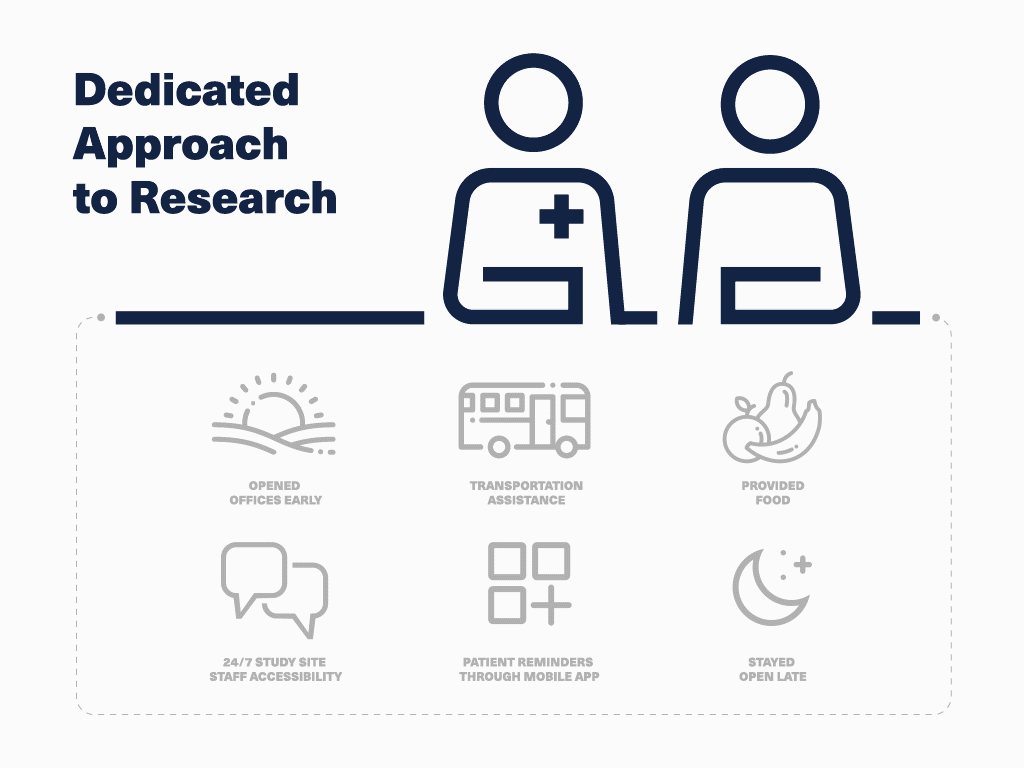4 Questions AbbVie Asked To Create More Diverse Clinical Trials
By Charlotte Owens, M.D., AbbVie

The U.S. Census continues to affirm what we see in healthcare every day — that our country is becoming more diverse. As an OBGYN and medical director at AbbVie working to develop medicines that help people live healthier lives, I believe we must ensure our trials include diverse groups of patients. Inclusivity in our clinical trials means better outcomes for all patients today and even 10 years from now. Accepting diverse perspectives is a key component of the process.
I’m an African American woman whose parents worked extremely hard and yet had limited material resources. The concept of access to healthcare was different for me compared to those of people I encountered as I went through my undergraduate studies. That was when I first stepped outside of my world view, my bubble. I was raised to value service to others, and it’s that foundation and background I carry with me, always striving to ensure all women have access to care. A goal of clinical trials is to include those who will ultimately benefit from the therapy. All patients deserve our attention and focus, so they’re afforded the opportunity to participate in the critical medical research, no matter their background or economic situation.
Over the five years I have been at AbbVie, the idea of diversity and inclusivity in healthcare was especially relevant to our clinical trials in uterine fibroids. This condition is the most common benign tumor in women of reproductive age and is present in up to 80 percent of African American women and 70 percent of Caucasian women by the time they reach menopause.1 We were able to successfully center patients in our program by understanding their needs, concerns, and desires, which enabled us to recruit and retain women representative of the patient landscape in this disease state. How? We asked ourselves four questions that guided us to overcome barriers to diversity.
1. Are you placing your clinical trial in locations where patients are getting their care?
Patients are at the core of the work we do. That means meeting them where they live and work. You must consider not only where the study sites will be, but also consider the challenges people may have getting to the clinic. In many communities, people often use public transportation, which may involve transfers and schedule challenges. Consider placing your study sites close to your patients’ homes or near a transportation hub to make access easier. Our team also offered transportation assistance, because the cost and inconvenience of an extra ride or two each way for each visit could become a significant barrier for some.
In our study, each woman had to visit monthly for more than a year and collect and carry one month’s worth of sanitary products from their home to the study site. This study requirement created another potential burden to participants. We provided inconspicuous tote bags to each woman because we knew our study participants would appreciate transporting study materials in a manner that maintained their privacy.

2. What does your investigator or provider makeup look like?
It is important to identify investigators or providers with the requisite specialty knowledge of the patient population. In addition to medical expertise, it is important that the study site teams are empathetic listeners, so they can understand the challenges participants face, and skilled communicators, so they can respond to their needs.
It’s often hard to understand what others value, believe, or need when you have different experiences, socioeconomic factors, or backgrounds. Your clinical trial team should also be diverse to bring forth multiple perspectives to the clinical trial. Everyone’s opinion on the study team is important. We all look at things through different lenses, which is what contributes to diverse solutions. Opening your study to different opinions and suggestions will help the clinical trial process be more robust, which enhances participant engagement and retention. You never know who on the team might have an insight you may have never thought of and that could be crucial to the success of your program.
3. Do you understand the patient and their family?
As I said, I grew up knowing that not everyone could easily go to the doctor for any reason, including wellness exams. In my childhood community, taking off from work to go to the doctor in the middle of the day was a significant challenge, if not out of the question due to the impact it had on work or finances. I brought that perspective to this trial. We encouraged our study sites to be mindful of the barriers that exist with the traditional 9-to-5 office hours and, when necessary, open early and stay open late. Also, knowing they may have little time in between their site visits and work or home, we had food readily available for them after times during the trial when they were required to fast.
4. What does the health of the community you’re trying to reach look like?
The reality we accepted heading into our clinical trial was many women, for a variety of reasons, may not have comprehensive healthcare. Many may be underinsured or have no insurance at all. This often leads to a lack of routine healthcare screening, treatment, or follow up, which may result in unknown comorbidities that prevent them from meeting the medical criteria required to participate in a clinical trial. If you don’t have the view of the total health landscape of the community, you may give up recruitment too easily or not understand the challenges that are part of your recruitment process.
For this study, we didn’t just think about the women impacted by uterine fibroids today. On average, it takes 10 years to bring a medicine to market. It is important to think about how the therapy will be applicable for the next decade. What will Gen Z women consider important for their health in the future? Is it the burden of heavy bleeding or will it be their desire to have a baby? Does our solution address these concerns?
Ask questions and think ahead. Listen to everyone’s opinions and perspectives. Put yourself in the shoes of those who will participate. Those are critical components of creating your own diverse and inclusive clinical trials.
References:
- Donnez, J., & Dolmans, M. M. (2016). Uterine fibroid management: from the present to the future. Human reproduction update, 22(6), 665–686. doi:10.1093/humupd/dmw023
About The Author:
 Charlotte Owens, M.D., FACOG, is a medical director at AbbVie in the general medicine therapeutic area with a focus on women’s health, where she is involved in the direction, planning, execution, and interpretation of clinical trials dedicated to delivering high-quality clinical data supporting overall product scientific and business strategy. Dr. Owens is also a board-certified obstetrician and gynecologist and continues to practice obstetrics and gynecology as an adjunct clinical assistant professor of obstetrics and gynecology in Atlanta.
Charlotte Owens, M.D., FACOG, is a medical director at AbbVie in the general medicine therapeutic area with a focus on women’s health, where she is involved in the direction, planning, execution, and interpretation of clinical trials dedicated to delivering high-quality clinical data supporting overall product scientific and business strategy. Dr. Owens is also a board-certified obstetrician and gynecologist and continues to practice obstetrics and gynecology as an adjunct clinical assistant professor of obstetrics and gynecology in Atlanta.
